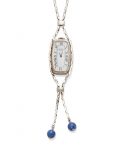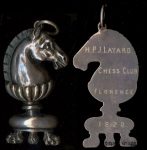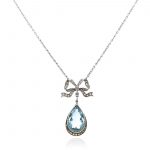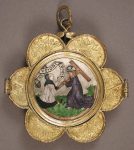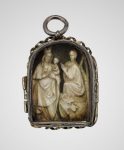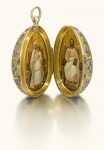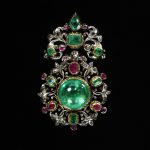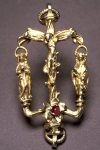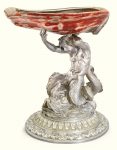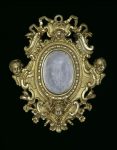Pendants. The word pendant derives from the Latin word pendere and Old French word pendr, both of which translate to “to hang down”. It comes in the form of a loose-hanging piece of jewellery, generally attached by a small loop to a necklace, which may be known as a “pendant necklace”. A pendant earring is an earring with a piece hanging down. In modern French, pendant is the gerund form of pendre (” to hang”) and also means “during”. The extent to which the design of a pendant can be incorporated into an overall necklace makes it not always accurate to treat them as separate items. Reference: Wikipedia
A silver and lapis lazuli pendant watch with integral chain, Gucci mechanical movement; case and dial signed; width: 21mm, length: 36in.
Sold for US$ 812 (£ 632) inc. premium at Bonhams in 2018
Pendant; silver; in form of chess-man: knight; standing cup with reeded bowl, stem and knop, moulded base; three paw feet; back flat with inscription; suspension loop. Date: 1820
Reference: © The Trustees of the British Museum
AN ART NOUVEAU SILVER, ENAMEL AND GOLD PENDANT, BY RENÉ LALIQUE The pendant designed as a nymph fairy, her sculpted silver body extending green and blue plique-à-jour enamel and gold wings, circa 1900, 4 3/4 ins. (pendant), 29 ins. (neckchain), to the 18k gold link neckchain, with areas of enamel loss Signed Lalique
Sold for USD 93,750 at Christies in 2018
AN ANTIQUE AQUAMARINE AND DIAMOND PENDANT NECKLACE in yellow gold and silver, suspending a pear shaped aquamarine encircled by diamonds below a diamond jewelled ribbon and bow motif, unmarked, 3.0cm, 7.1g.
Sold for £1,200 at Elmwood’s in 2019
Reliquary Pendant Date:15th century Culture:French Medium: Basse taille enamel, niello, silver, silver-gilt
A man, probably the owner of this pendant, kneels and greets Jesus carrying his cross, appearing to him as if in a vision.
Reference: The Metropolitan Museum of Art
Pendant, pencil in holder, waratah design, enamel/ silver gilt/ wood, unknown maker, England, c 1910, retailed by Flavelle Bros Ltd in Sydney in 1912 ; in original case. Made in United Kingdom, Europe, c 1910. Today very rare, this piece was acquired by the Museum for its spectacular ‘Australian flora in applied art ‘ exhibition of approximately 200 decorative arts objects both Australian made and commissioned overseas, predominantly in England, for the Australian market. The exhibition opened in 1906 and continued, with new objects being added throughout its duration, until the 1930s. This exhibition travelled to San Francisco as the Australian entrant in the Pacific International Exposition of 1915.
Reference: Museum of Applied Art and Sciences
Pendant English Medieval (Gothic) 14th century
Obv: Standing Virgin with Child, St. Margrite seated on dragon in ivory relief. Rev: Tortoise-shell. Framed in hinged and molded silver with twisted wire decoration, ring at arched top.
p>Reference: Museum of Fine Arts BostonAn egg-shaped silver-gilt and cloisonné enamel pendant icon, 11th Artel, Moscow, 1908-1917 decorated with a band of polychrome rosettes and divided by white-lined intersections surrounding blue, green and red scrolling foliage on gilt stippled grounds, opening to reveal an icon of the enthroned Virgin and Child and other of Christ Pantocrator, with circular suspension ring, 84 standard height with loop 10.5cm, 4 1/8 in.
Sold for 18,750 GBP at Sothebys in 2018
Silver and gilded silver pendant, set with emeralds, rubies and rose- and table-cut diamonds, the back engraved. The central emerald a later addition Place of Origin Germany (made) Date ca. 1700 (made)
Reference: © Victoria and Albert Museum
This pendant, meant to prompt meditation as well as to provide ornamentation, takes the shape of the Crucifixion, with Mary and St. John on either side of Christ. The cross is represented as the Tree of Life, with a ruby set below Christ’s feet. The ring at the top was for a chain to suspend the pendant, while that at the bottom was probably for a pearl, a common addition to many pendants of the time.
German late 15th century (Late Medieval)
Reference: The Walters Art Museum
